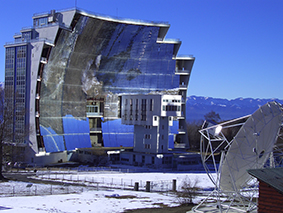Numerical investigation of tilt angle effect on a Direct Steam Generation solar receiver
Résumé
Direct steam generation (DSG), which is currently gaining renewed interest in concentrated solar power technologies, offers several advantages, such as reducing the number of components in the plant and lowering operating costs by replacing conventional heat transfer fluids -usually synthetic oils or molten salts -with water. However, it also introduces certain complexities due to the two-phase flow in the receiver. In horizontal receivers, gravity tends to separate the two phases, generating a stratified flow regime. In this regime, steam transfers heat less efficiently, causing the upper part of the receiver to overheat and creating significant temperature gradients within the receiver. These gradients can lead to fatigue and reduce the lifespan of components. Therefore, predicting flow regimes is crucial for the design and operation of solar power plants. In pursuit of this objective, we are developing a 3D transient modeling tool using the NEPTUNE_CFD and Syrthes software to account for the two-phase flow dynamic and coupled heat transfers within the receiver. Simulations, based on a 67 m long receiver module from the eLLO plant, study the influence of the receiver's inclination and the distribution of concentrated solar flux on the receiver's performance. The results show that flux distribution mainly affects the temperature distribution in the solid but does not impact steam production. Flow regimes are strongly influenced by the receiver's inclination. Downward configurations promote steam production at the cost of greater temperature gradients.
| Origine | Publication financée par une institution |
|---|---|
| licence |





